| |
|
Aaron's Tour of
Los Angeles - Part 1
|
El Pueblo Historic
District, New Downtown, and Hollywood
 |
|
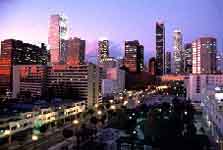 |
The "new
downtown" (or "Bunker Hill," or "financial district")
in Los Angeles is largely the product of the efforts of the Community
Redevelopment Agency of the City. Beginning in the 1960s this agency
coordinated the investment of millions of dollars to develop a "new"
downtown with a tall skyscraper profile that would contribute to
Los Angeles' world city status. Having major office buildings and
hotels, today the area is a focal point for international capital
and international travelers. Although it might seem logical to visit
the "Old Downtown" after visiting El Pueblo, that tour
is more extensive and demands its own day. Part 1 of the L.A. tour
is meant to be more for of a panaromic view of the downtown area. |
|
1. Pershing Square
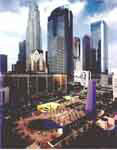 In 1886, this five acre plot of land
was set aside for public use, surpassing the older plaza near
Olvera Street in popularity due to the southwest population shift
at that time. In 1918, the square was named for General John J.
Pershing. Its postmodern redesign by Ricardo Legorreta, dedicated
in February of 1994, is full of symbols of California life. A
fault line runs from one corner of the park to the other and postcards
are embedded in park benches. The dominant visual feature of the
park is a 120-foot high purple tower. Be sure to read the interesting
message on the back of the wall surrounding the waterfall. Walk
across the street to the Biltmore Hotel. In 1886, this five acre plot of land
was set aside for public use, surpassing the older plaza near
Olvera Street in popularity due to the southwest population shift
at that time. In 1918, the square was named for General John J.
Pershing. Its postmodern redesign by Ricardo Legorreta, dedicated
in February of 1994, is full of symbols of California life. A
fault line runs from one corner of the park to the other and postcards
are embedded in park benches. The dominant visual feature of the
park is a 120-foot high purple tower. Be sure to read the interesting
message on the back of the wall surrounding the waterfall. Walk
across the street to the Biltmore Hotel.
|
|
2.
Biltmore Hotel
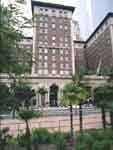 The
Biltmore Hotel was opened in 1923 at a cost of 7 million dollars.
At one time, it was the largest hotel in Los Angeles with over
a 1000 rooms. Today it is the ninth largest in Los Angeles, and
the third largest in Downtown with 683 rooms. Designed by the
New York firm of Schultze and Weaver, it has reddish brick, terra
cotta roof tile, cream-colored stone, and three towers on the
facade make the building instantly recognizable. In 1960, it served
as the headquarters for the Democratic National Convention, at
which John F. Kennedy was nominated for President. Over the years,
the hotel has been refurbished numerous times, with special effort
to preserve the murals and ceilings done by Giovani Battista Smeraldi,
whose paintings are also in the Blue Room of the White House.
A major renovation in the late eighties included a tower of 24
stories. Be sure to check out its four major ballrooms The
Emerald, Gold, Crystal and Tiffany rooms as well as the
two lobbies. Exit the hotel near the Emerald Room, and head over
to the bank building that used to be the Old California Edison
Building. The
Biltmore Hotel was opened in 1923 at a cost of 7 million dollars.
At one time, it was the largest hotel in Los Angeles with over
a 1000 rooms. Today it is the ninth largest in Los Angeles, and
the third largest in Downtown with 683 rooms. Designed by the
New York firm of Schultze and Weaver, it has reddish brick, terra
cotta roof tile, cream-colored stone, and three towers on the
facade make the building instantly recognizable. In 1960, it served
as the headquarters for the Democratic National Convention, at
which John F. Kennedy was nominated for President. Over the years,
the hotel has been refurbished numerous times, with special effort
to preserve the murals and ceilings done by Giovani Battista Smeraldi,
whose paintings are also in the Blue Room of the White House.
A major renovation in the late eighties included a tower of 24
stories. Be sure to check out its four major ballrooms The
Emerald, Gold, Crystal and Tiffany rooms as well as the
two lobbies. Exit the hotel near the Emerald Room, and head over
to the bank building that used to be the Old California Edison
Building.
|
|
3. Cal. Edison
Building
This beautiful building was the first all-electric
office building and home to the California Edison Company, which
provided power to the area and helped Los Angeles grow. Be sure
to walk past the security officer's desk and down the hallway
to see pictures of what the area looked like at the time it was
built. Exit and turn right, notice the huge building you are walking
by (the Library Tower) as it is the tallest building in Los Angeles,
and the beautiful Bunker Hill steps to your right with water flowing
down the center. Cross the street to the Central Library.
|
|
4. Central Library
 After several locations since first
being established in 1878, the Los Angeles Public library found
a home in this specially-designed building. The building, designed
by Bertram G. Goodhue, was dedicated on July 15, 1926. Goodhue's
design was modeled after the architect's previous creation, the
Nebraska State Capitol Building in Lincoln. (The latter, by the
way, is much taller--40 stories and 432 feet tall--and is often
referred to as "the penis of the plains.") For many
years the library had numerous entrances, tide pools, and rolling
expanses of grass. One by one these features were reduced due
to the growth of downtown and the need for parking. In the eighties
two arson fires damaged the building and tens of thousands of
books, resulting in major renovation and the addition of the rear
atrium. The building accurately resembles its original look, yet
the new wing adds a post modern feel. The atrium also allows natural
light into the building, much like the Bradbury Building, allowing
visitors to escape the chaos of downtown. The air space above
was sold to the developers of the Library Tower (across the street)
so that they could build the tallest building between Chicago
and Hong Kong. After several locations since first
being established in 1878, the Los Angeles Public library found
a home in this specially-designed building. The building, designed
by Bertram G. Goodhue, was dedicated on July 15, 1926. Goodhue's
design was modeled after the architect's previous creation, the
Nebraska State Capitol Building in Lincoln. (The latter, by the
way, is much taller--40 stories and 432 feet tall--and is often
referred to as "the penis of the plains.") For many
years the library had numerous entrances, tide pools, and rolling
expanses of grass. One by one these features were reduced due
to the growth of downtown and the need for parking. In the eighties
two arson fires damaged the building and tens of thousands of
books, resulting in major renovation and the addition of the rear
atrium. The building accurately resembles its original look, yet
the new wing adds a post modern feel. The atrium also allows natural
light into the building, much like the Bradbury Building, allowing
visitors to escape the chaos of downtown. The air space above
was sold to the developers of the Library Tower (across the street)
so that they could build the tallest building between Chicago
and Hong Kong.
|
|
5. Bonaventure
Hotel
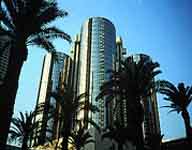 The Westin Bonaventure Hotel was built
between 1974 and 1976. The hotel is designed as four cylinders
surrounding one larger cylinder, and its elevators operate on
the outside of the building on the upper floors. The predominately
glass exterior reflects the blue of a typical Los Angeles' sky.
Walk through the hotel and, if you can find your way, exit on
the sixth floor and walk across the street on the pedestrian overpass.
You will walk by the downtown YMCA. Hang a left and walk over
the street to the Arco building. As you cross, notice how one
of the Wells Fargo Towers (reddish stone) appears to be two-dimensional.
Pretty cool, eh? The Westin Bonaventure Hotel was built
between 1974 and 1976. The hotel is designed as four cylinders
surrounding one larger cylinder, and its elevators operate on
the outside of the building on the upper floors. The predominately
glass exterior reflects the blue of a typical Los Angeles' sky.
Walk through the hotel and, if you can find your way, exit on
the sixth floor and walk across the street on the pedestrian overpass.
You will walk by the downtown YMCA. Hang a left and walk over
the street to the Arco building. As you cross, notice how one
of the Wells Fargo Towers (reddish stone) appears to be two-dimensional.
Pretty cool, eh?
|
|
6. ARCO Plaza
Yes, ARCO helped ruin public transportation in
Los Angeles, as was documented in "Who Framed Roger Rabbit?"
It was Standard Oil at the time, and along with the tire companies
and other car-related interests, it bought up the yellow cars
and red cars, and shut them down. Los Angeles went from having
one of the best public transportation systems to having no public
transportation almost overnight. Feel free to picket outside the
building. Once you are done with that activity, walk around its
gardens, as this is where Julia Roberts read a book with Richard
Gere in "Pretty Woman" and the building is where his
business deals took place (recognize the red, metal sculpture
in the front?). Next, walk across the street to the Court at Well's
Fargo Center and find your way to the Well's Fargo History Museum.
|
|
7. Wells Fargo
Museum
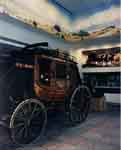 Once part of the Pony Express, the
name says it all. If you are interested in the history of banking,
this should be interesting. Also, there are a few neat maps inside
detailing the early developments of Los Angeles and Pasadena.
Next, walk through the Wells Fargo Towers and cross the street. Once part of the Pony Express, the
name says it all. If you are interested in the history of banking,
this should be interesting. Also, there are a few neat maps inside
detailing the early developments of Los Angeles and Pasadena.
Next, walk through the Wells Fargo Towers and cross the street.
|
|
8. California
Plaza
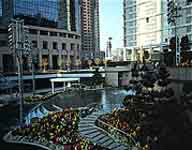 Construction of this project began
in 1983,. The project was completed in 1992 and included two office
towers (42 and 55 stories) with 2.4 million square feet of leasable
space, the 469-room Hotel InterContinental, and 150 residential
condominium units (The MuseumTower). An interesting water court
is the product of a "one percent for art" initiative
on new buildings that applied to much of the new downtown. Walk
across the Plaza to Angel's Flight. Construction of this project began
in 1983,. The project was completed in 1992 and included two office
towers (42 and 55 stories) with 2.4 million square feet of leasable
space, the 469-room Hotel InterContinental, and 150 residential
condominium units (The MuseumTower). An interesting water court
is the product of a "one percent for art" initiative
on new buildings that applied to much of the new downtown. Walk
across the Plaza to Angel's Flight.
|
|
9.
Angel's Flight
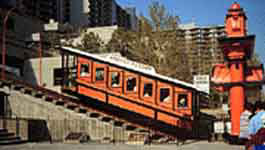 The Angels Flight funicular opened
in February 1996. It provided transportation for the wealthy whom
once resided at the top of Bunker Hill to the downtown area below.
Angel's Flight was first opened on December 31, 1901 by one of
Abraham Lincoln's friends. It was originally black and white (not
orange), but it was repainted some years later. It was closed
and dismantled on May 18, 1969 for "repairs," and the
area at the top of Bunker Hill had fallen into disrepair. The
victorian mansions that once stood at the top of Bunker Hill had
all been relocated. A long-time symbol of the city, as demonstrated
by posters of when the Olympics were in Los Angeles in the earlier
part of the twentieth century, letters continued to pour into
the city for twenty-seven years until the funicular was finally
re-opened on February 24, 1996. The funicular was reopened a block
away from where it originally operated, and it now serves the
business men and women whom work in the skyscrapers built atop
Bunker Hill. Be sure to watch how close the two counterbalanced
cars come within one another! Take Angel's Flight down to the
street, and cross to Grand Central Market. The Angels Flight funicular opened
in February 1996. It provided transportation for the wealthy whom
once resided at the top of Bunker Hill to the downtown area below.
Angel's Flight was first opened on December 31, 1901 by one of
Abraham Lincoln's friends. It was originally black and white (not
orange), but it was repainted some years later. It was closed
and dismantled on May 18, 1969 for "repairs," and the
area at the top of Bunker Hill had fallen into disrepair. The
victorian mansions that once stood at the top of Bunker Hill had
all been relocated. A long-time symbol of the city, as demonstrated
by posters of when the Olympics were in Los Angeles in the earlier
part of the twentieth century, letters continued to pour into
the city for twenty-seven years until the funicular was finally
re-opened on February 24, 1996. The funicular was reopened a block
away from where it originally operated, and it now serves the
business men and women whom work in the skyscrapers built atop
Bunker Hill. Be sure to watch how close the two counterbalanced
cars come within one another! Take Angel's Flight down to the
street, and cross to Grand Central Market.
Warning: There was recently an accident
on Angel's Flight and it might be closed.
|
|
10.
Grand Central Market
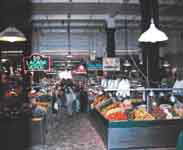 Built in 1917, the Grand Central Market
is a cavernous European-style market under great overhead fans.
It is the oldest of all concession type markets on the Pacific
Coast, and was the first earthquake and fireproof building in
Los Angeles. The Grand Central Market is an indoor bazaar that
extends from Broadway to Hill Street. It is crowded, frenzied,
and picturesque. The stalls and aisles overflow with exotic foods,
from pigs tongues to passion fruit. Exit on the other side and
cross the street to get to the Bradbury Building. Built in 1917, the Grand Central Market
is a cavernous European-style market under great overhead fans.
It is the oldest of all concession type markets on the Pacific
Coast, and was the first earthquake and fireproof building in
Los Angeles. The Grand Central Market is an indoor bazaar that
extends from Broadway to Hill Street. It is crowded, frenzied,
and picturesque. The stalls and aisles overflow with exotic foods,
from pigs tongues to passion fruit. Exit on the other side and
cross the street to get to the Bradbury Building.
|
|
11. Bradbury
Building
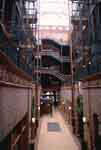 The Bradbury Building, built in 1893,
is one of Southern California's most remarkable architectural
achievements. Its plan was commissioned by real estate and mining
entrepreneur Louis L. Bradbury who decided to build it just a
few blocks from his home on fashionable Bunker Hill and not far
from the base of Angels Flight. After rejecting a plan submitted
by Sumner P. Hunt, Bradbury approached junior draftsman George
Wyman. Wyman is said to have accepted the commission after consulting
a ouija board. Wyman was influenced by Edward Bellamy's 1887 book
that described a utopian civilization in the year 2000. The typical
office building was described as being a "vast hall of light
received not alone by the windows, but from a dome overhead."
The interior of the court is flooded with natural light. In the
true spirit of Los Angles, it has been featured in many movies,
from DOA in 1946 to Blade Runner to Disclosure. Return to the
Pershing Square Metro Station. The Bradbury Building, built in 1893,
is one of Southern California's most remarkable architectural
achievements. Its plan was commissioned by real estate and mining
entrepreneur Louis L. Bradbury who decided to build it just a
few blocks from his home on fashionable Bunker Hill and not far
from the base of Angels Flight. After rejecting a plan submitted
by Sumner P. Hunt, Bradbury approached junior draftsman George
Wyman. Wyman is said to have accepted the commission after consulting
a ouija board. Wyman was influenced by Edward Bellamy's 1887 book
that described a utopian civilization in the year 2000. The typical
office building was described as being a "vast hall of light
received not alone by the windows, but from a dome overhead."
The interior of the court is flooded with natural light. In the
true spirit of Los Angles, it has been featured in many movies,
from DOA in 1946 to Blade Runner to Disclosure. Return to the
Pershing Square Metro Station.
|
|
TRANSITION
 Take the
MTA Red Line from Pershing Square to Hollywood/Highland Station,
where the "Hollywood" part of the tour begins. (Click
here or on the subway to continue
the tour) Take the
MTA Red Line from Pershing Square to Hollywood/Highland Station,
where the "Hollywood" part of the tour begins. (Click
here or on the subway to continue
the tour)
|
|
|

 In 1886, this five acre plot of land
was set aside for public use, surpassing the older plaza near
Olvera Street in popularity due to the southwest population shift
at that time. In 1918, the square was named for General John J.
Pershing. Its postmodern redesign by Ricardo Legorreta, dedicated
in February of 1994, is full of symbols of California life. A
fault line runs from one corner of the park to the other and postcards
are embedded in park benches. The dominant visual feature of the
park is a 120-foot high purple tower. Be sure to read the interesting
message on the back of the wall surrounding the waterfall. Walk
across the street to the Biltmore Hotel.
In 1886, this five acre plot of land
was set aside for public use, surpassing the older plaza near
Olvera Street in popularity due to the southwest population shift
at that time. In 1918, the square was named for General John J.
Pershing. Its postmodern redesign by Ricardo Legorreta, dedicated
in February of 1994, is full of symbols of California life. A
fault line runs from one corner of the park to the other and postcards
are embedded in park benches. The dominant visual feature of the
park is a 120-foot high purple tower. Be sure to read the interesting
message on the back of the wall surrounding the waterfall. Walk
across the street to the Biltmore Hotel. The
Biltmore Hotel was opened in 1923 at a cost of 7 million dollars.
At one time, it was the largest hotel in Los Angeles with over
a 1000 rooms. Today it is the ninth largest in Los Angeles, and
the third largest in Downtown with 683 rooms. Designed by the
New York firm of Schultze and Weaver, it has reddish brick, terra
cotta roof tile, cream-colored stone, and three towers on the
facade make the building instantly recognizable. In 1960, it served
as the headquarters for the Democratic National Convention, at
which John F. Kennedy was nominated for President. Over the years,
the hotel has been refurbished numerous times, with special effort
to preserve the murals and ceilings done by Giovani Battista Smeraldi,
whose paintings are also in the Blue Room of the White House.
A major renovation in the late eighties included a tower of 24
stories. Be sure to check out its four major ballrooms The
Emerald, Gold, Crystal and Tiffany rooms as well as the
two lobbies. Exit the hotel near the Emerald Room, and head over
to the bank building that used to be the Old California Edison
Building.
The
Biltmore Hotel was opened in 1923 at a cost of 7 million dollars.
At one time, it was the largest hotel in Los Angeles with over
a 1000 rooms. Today it is the ninth largest in Los Angeles, and
the third largest in Downtown with 683 rooms. Designed by the
New York firm of Schultze and Weaver, it has reddish brick, terra
cotta roof tile, cream-colored stone, and three towers on the
facade make the building instantly recognizable. In 1960, it served
as the headquarters for the Democratic National Convention, at
which John F. Kennedy was nominated for President. Over the years,
the hotel has been refurbished numerous times, with special effort
to preserve the murals and ceilings done by Giovani Battista Smeraldi,
whose paintings are also in the Blue Room of the White House.
A major renovation in the late eighties included a tower of 24
stories. Be sure to check out its four major ballrooms The
Emerald, Gold, Crystal and Tiffany rooms as well as the
two lobbies. Exit the hotel near the Emerald Room, and head over
to the bank building that used to be the Old California Edison
Building. After several locations since first
being established in 1878, the Los Angeles Public library found
a home in this specially-designed building. The building, designed
by Bertram G. Goodhue, was dedicated on July 15, 1926. Goodhue's
design was modeled after the architect's previous creation, the
Nebraska State Capitol Building in Lincoln. (The latter, by the
way, is much taller--40 stories and 432 feet tall--and is often
referred to as "the penis of the plains.") For many
years the library had numerous entrances, tide pools, and rolling
expanses of grass. One by one these features were reduced due
to the growth of downtown and the need for parking. In the eighties
two arson fires damaged the building and tens of thousands of
books, resulting in major renovation and the addition of the rear
atrium. The building accurately resembles its original look, yet
the new wing adds a post modern feel. The atrium also allows natural
light into the building, much like the Bradbury Building, allowing
visitors to escape the chaos of downtown. The air space above
was sold to the developers of the Library Tower (across the street)
so that they could build the tallest building between Chicago
and Hong Kong.
After several locations since first
being established in 1878, the Los Angeles Public library found
a home in this specially-designed building. The building, designed
by Bertram G. Goodhue, was dedicated on July 15, 1926. Goodhue's
design was modeled after the architect's previous creation, the
Nebraska State Capitol Building in Lincoln. (The latter, by the
way, is much taller--40 stories and 432 feet tall--and is often
referred to as "the penis of the plains.") For many
years the library had numerous entrances, tide pools, and rolling
expanses of grass. One by one these features were reduced due
to the growth of downtown and the need for parking. In the eighties
two arson fires damaged the building and tens of thousands of
books, resulting in major renovation and the addition of the rear
atrium. The building accurately resembles its original look, yet
the new wing adds a post modern feel. The atrium also allows natural
light into the building, much like the Bradbury Building, allowing
visitors to escape the chaos of downtown. The air space above
was sold to the developers of the Library Tower (across the street)
so that they could build the tallest building between Chicago
and Hong Kong. The Westin Bonaventure Hotel was built
between 1974 and 1976. The hotel is designed as four cylinders
surrounding one larger cylinder, and its elevators operate on
the outside of the building on the upper floors. The predominately
glass exterior reflects the blue of a typical Los Angeles' sky.
Walk through the hotel and, if you can find your way, exit on
the sixth floor and walk across the street on the pedestrian overpass.
You will walk by the downtown YMCA. Hang a left and walk over
the street to the Arco building. As you cross, notice how one
of the Wells Fargo Towers (reddish stone) appears to be two-dimensional.
Pretty cool, eh?
The Westin Bonaventure Hotel was built
between 1974 and 1976. The hotel is designed as four cylinders
surrounding one larger cylinder, and its elevators operate on
the outside of the building on the upper floors. The predominately
glass exterior reflects the blue of a typical Los Angeles' sky.
Walk through the hotel and, if you can find your way, exit on
the sixth floor and walk across the street on the pedestrian overpass.
You will walk by the downtown YMCA. Hang a left and walk over
the street to the Arco building. As you cross, notice how one
of the Wells Fargo Towers (reddish stone) appears to be two-dimensional.
Pretty cool, eh? Once part of the Pony Express, the
name says it all. If you are interested in the history of banking,
this should be interesting. Also, there are a few neat maps inside
detailing the early developments of Los Angeles and Pasadena.
Next, walk through the Wells Fargo Towers and cross the street.
Once part of the Pony Express, the
name says it all. If you are interested in the history of banking,
this should be interesting. Also, there are a few neat maps inside
detailing the early developments of Los Angeles and Pasadena.
Next, walk through the Wells Fargo Towers and cross the street. Construction of this project began
in 1983,. The project was completed in 1992 and included two office
towers (42 and 55 stories) with 2.4 million square feet of leasable
space, the 469-room Hotel InterContinental, and 150 residential
condominium units (The MuseumTower). An interesting water court
is the product of a "one percent for art" initiative
on new buildings that applied to much of the new downtown. Walk
across the Plaza to Angel's Flight.
Construction of this project began
in 1983,. The project was completed in 1992 and included two office
towers (42 and 55 stories) with 2.4 million square feet of leasable
space, the 469-room Hotel InterContinental, and 150 residential
condominium units (The MuseumTower). An interesting water court
is the product of a "one percent for art" initiative
on new buildings that applied to much of the new downtown. Walk
across the Plaza to Angel's Flight. The Angels Flight funicular opened
in February 1996. It provided transportation for the wealthy whom
once resided at the top of Bunker Hill to the downtown area below.
Angel's Flight was first opened on December 31, 1901 by one of
Abraham Lincoln's friends. It was originally black and white (not
orange), but it was repainted some years later. It was closed
and dismantled on May 18, 1969 for "repairs," and the
area at the top of Bunker Hill had fallen into disrepair. The
victorian mansions that once stood at the top of Bunker Hill had
all been relocated. A long-time symbol of the city, as demonstrated
by posters of when the Olympics were in Los Angeles in the earlier
part of the twentieth century, letters continued to pour into
the city for twenty-seven years until the funicular was finally
re-opened on February 24, 1996. The funicular was reopened a block
away from where it originally operated, and it now serves the
business men and women whom work in the skyscrapers built atop
Bunker Hill. Be sure to watch how close the two counterbalanced
cars come within one another! Take Angel's Flight down to the
street, and cross to Grand Central Market.
The Angels Flight funicular opened
in February 1996. It provided transportation for the wealthy whom
once resided at the top of Bunker Hill to the downtown area below.
Angel's Flight was first opened on December 31, 1901 by one of
Abraham Lincoln's friends. It was originally black and white (not
orange), but it was repainted some years later. It was closed
and dismantled on May 18, 1969 for "repairs," and the
area at the top of Bunker Hill had fallen into disrepair. The
victorian mansions that once stood at the top of Bunker Hill had
all been relocated. A long-time symbol of the city, as demonstrated
by posters of when the Olympics were in Los Angeles in the earlier
part of the twentieth century, letters continued to pour into
the city for twenty-seven years until the funicular was finally
re-opened on February 24, 1996. The funicular was reopened a block
away from where it originally operated, and it now serves the
business men and women whom work in the skyscrapers built atop
Bunker Hill. Be sure to watch how close the two counterbalanced
cars come within one another! Take Angel's Flight down to the
street, and cross to Grand Central Market. Built in 1917, the Grand Central Market
is a cavernous European-style market under great overhead fans.
It is the oldest of all concession type markets on the Pacific
Coast, and was the first earthquake and fireproof building in
Los Angeles. The Grand Central Market is an indoor bazaar that
extends from Broadway to Hill Street. It is crowded, frenzied,
and picturesque. The stalls and aisles overflow with exotic foods,
from pigs tongues to passion fruit. Exit on the other side and
cross the street to get to the Bradbury Building.
Built in 1917, the Grand Central Market
is a cavernous European-style market under great overhead fans.
It is the oldest of all concession type markets on the Pacific
Coast, and was the first earthquake and fireproof building in
Los Angeles. The Grand Central Market is an indoor bazaar that
extends from Broadway to Hill Street. It is crowded, frenzied,
and picturesque. The stalls and aisles overflow with exotic foods,
from pigs tongues to passion fruit. Exit on the other side and
cross the street to get to the Bradbury Building. The Bradbury Building, built in 1893,
is one of Southern California's most remarkable architectural
achievements. Its plan was commissioned by real estate and mining
entrepreneur Louis L. Bradbury who decided to build it just a
few blocks from his home on fashionable Bunker Hill and not far
from the base of Angels Flight. After rejecting a plan submitted
by Sumner P. Hunt, Bradbury approached junior draftsman George
Wyman. Wyman is said to have accepted the commission after consulting
a ouija board. Wyman was influenced by Edward Bellamy's 1887 book
that described a utopian civilization in the year 2000. The typical
office building was described as being a "vast hall of light
received not alone by the windows, but from a dome overhead."
The interior of the court is flooded with natural light. In the
true spirit of Los Angles, it has been featured in many movies,
from DOA in 1946 to Blade Runner to Disclosure. Return to the
Pershing Square Metro Station.
The Bradbury Building, built in 1893,
is one of Southern California's most remarkable architectural
achievements. Its plan was commissioned by real estate and mining
entrepreneur Louis L. Bradbury who decided to build it just a
few blocks from his home on fashionable Bunker Hill and not far
from the base of Angels Flight. After rejecting a plan submitted
by Sumner P. Hunt, Bradbury approached junior draftsman George
Wyman. Wyman is said to have accepted the commission after consulting
a ouija board. Wyman was influenced by Edward Bellamy's 1887 book
that described a utopian civilization in the year 2000. The typical
office building was described as being a "vast hall of light
received not alone by the windows, but from a dome overhead."
The interior of the court is flooded with natural light. In the
true spirit of Los Angles, it has been featured in many movies,
from DOA in 1946 to Blade Runner to Disclosure. Return to the
Pershing Square Metro Station.